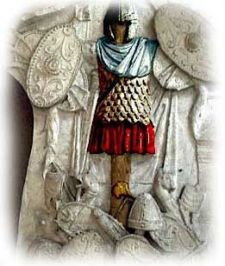 |
 |
| Home | Activity | Projects | Members | Reenactment | Media | Forum | Links | Contact |
|---|
 |
|---|
 ::Reenactment resources::
::Reenactment resources::
 |
|---|
|
Dacian army Dacians have entered the historical arena of south-eastern Europe in the end of the first millennium B.C. Numerous literary sources mention them and our knowledge on this ancient civilization is completed by the results of archaeological research. In order to organize ample military campaigns against the Bastarni, Celts, Greeks, Sarmatians, and Romans, the Dacians needed an army equipped according to the needs of those times, but it is rather difficult to establish and recreate the characteristics of weapons (and how they were used together in war) and the specificity of Dacian military art. Literary sources are almost silent on the topic and few tombs of Dacian warriors have been discovered archaeologically, due to the so-called “tombs void” in Dacian history (first century B.C – first century A.D.). The Dacian army consisted of pedestrian warriors (common people, the so-called comati) and riders (mostly nobles, called tarabostes or pileati by the sources). The offensive weapons of the Dacian cavalry included long straight swords, used for cutting, lances and spears for throwing, and the ever-present bows and arrows. Archers probably formed separate cavalry units. For defense, the Dacians used oval shields, helmets and armors (coat of mail, iron segments and leather cuirasses). The enumeration of riders’ weapons reveals the existence of a light cavalry (armed with sword, shield, and maybe a lance or a spear) and a heavy cavalry, probably less numerous, composed of heavily armed warriors wearing armor. The pieces of armor and coats of mail worn by each rider were probably indicators of rank. Pedestrian fighters carried spears/lances, shields, and either curve (falx) or short and straight swords (with one or two cutting edges) and battle knives or daggers (sica); it seems that some of them also had battle axes and sickles. During fights at a distance the Dacians used Scythian-type bows and lances and/or spears. Dacian infantry men protected themselves only with shields. Certain subdivisions could be noted in the infantery, such as warriors with pileus and those not wearing the typical Dacian cap, or those only using the falx in their fighting style. The latter warriors probably constituted an elite unit, probably around the capital. Considering the above enumeration of Dacian types of weapons, one can observe that these fighters were more successful in close confrontations, since the distance weapons are less numerous among the discoveries. The falx and the sica, the two “ethnical” weapons of the Dacians became renown due to their efficacy in close-range fights. In order to obtain maximum efficiency from the use of these weapons, it can be presumed that mixed formation of warriors with falx and sica existed and they were able of penetrating or harassing enemy formations. Such mixed groups annulled the disadvantages of each type of weapon. The warriors armed only with the falx could have been protected against Roman swords by the shields of those fighting with the sica, since the latter were only effective in individual close-range confrontations. One can presume that for the optimal efficiency against Roman formations two Dacians fighting with the sica flanked each warrior with falx. The fact that most Dacians are lightly armed testifies to the mobility of their army. Shields were needed in rapid maneuvers and regrouping. Their shape was designed for both in formation and individual fighting. In the latter case, Dacians were in advantage against heavier and thus slower enemies. Please see and comment on the Dacian equipment recreated by the Terra Dacia Aeterna illustrated in the Reenactment section of the forum and the Media-Photo section of this site. |
|---|
2008 Copyright | All rights reserved Terra Dacica Aeterna |
